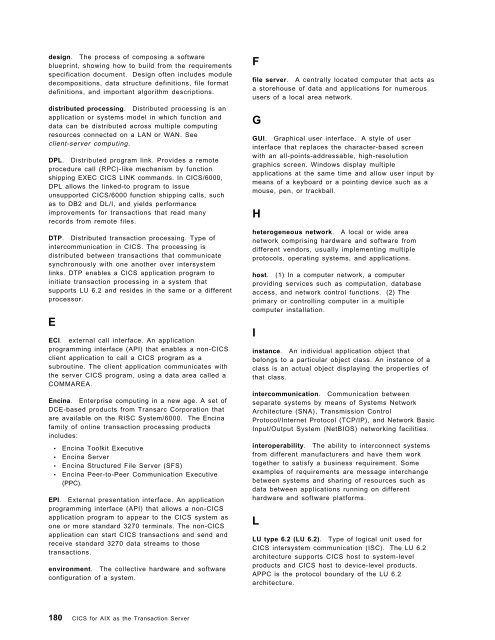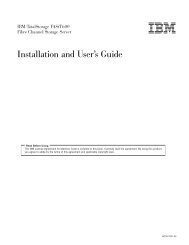Addressing OLTP Solutions with CICS: The Transaction Server ... - Ibm
Addressing OLTP Solutions with CICS: The Transaction Server ... - Ibm
Addressing OLTP Solutions with CICS: The Transaction Server ... - Ibm
You also want an ePaper? Increase the reach of your titles
YUMPU automatically turns print PDFs into web optimized ePapers that Google loves.
design. <strong>The</strong> process of composing a software<br />
blueprint, showing how to build from the requirements<br />
specification document. Design often includes module<br />
decompositions, data structure definitions, file format<br />
definitions, and important algorithm descriptions.<br />
distributed processing. Distributed processing is an<br />
application or systems model in which function and<br />
data can be distributed across multiple computing<br />
resources connected on a LAN or WAN. See<br />
client-server computing.<br />
DPL. Distributed program link. Provides a remote<br />
procedure call (RPC)-like mechanism by function<br />
shipping EXEC <strong>CICS</strong> LINK commands. In <strong>CICS</strong>/6000,<br />
DPL allows the linked-to program to issue<br />
unsupported <strong>CICS</strong>/6000 function shipping calls, such<br />
as to DB2 and DL/I, and yields performance<br />
improvements for transactions that read many<br />
records from remote files.<br />
DTP. Distributed transaction processing. Type of<br />
intercommunication in <strong>CICS</strong>. <strong>The</strong> processing is<br />
distributed between transactions that communicate<br />
synchronously <strong>with</strong> one another over intersystem<br />
links. DTP enables a <strong>CICS</strong> application program to<br />
initiate transaction processing in a system that<br />
supports LU 6.2 and resides in the same or a different<br />
processor.<br />
E<br />
ECI. external call interface. An application<br />
programming interface (API) that enables a non-<strong>CICS</strong><br />
client application to call a <strong>CICS</strong> program as a<br />
subroutine. <strong>The</strong> client application communicates <strong>with</strong><br />
the server <strong>CICS</strong> program, using a data area called a<br />
COMMAREA.<br />
Encina. Enterprise computing in a new age. A set of<br />
DCE-based products from Transarc Corporation that<br />
are available on the RISC System/6000. <strong>The</strong> Encina<br />
family of online transaction processing products<br />
includes:<br />
• Encina Toolkit Executive<br />
• Encina <strong>Server</strong><br />
• Encina Structured File <strong>Server</strong> (SFS)<br />
• Encina Peer-to-Peer Communication Executive<br />
(PPC).<br />
EPI. External presentation interface. An application<br />
programming interface (API) that allows a non-<strong>CICS</strong><br />
application program to appear to the <strong>CICS</strong> system as<br />
one or more standard 3270 terminals. <strong>The</strong> non-<strong>CICS</strong><br />
application can start <strong>CICS</strong> transactions and send and<br />
receive standard 3270 data streams to those<br />
transactions.<br />
environment. <strong>The</strong> collective hardware and software<br />
configuration of a system.<br />
180 <strong>CICS</strong> for AIX as the <strong>Transaction</strong> <strong>Server</strong><br />
F<br />
file server. A centrally located computer that acts as<br />
a storehouse of data and applications for numerous<br />
users of a local area network.<br />
G<br />
GUI. Graphical user interface. A style of user<br />
interface that replaces the character-based screen<br />
<strong>with</strong> an all-points-addressable, high-resolution<br />
graphics screen. Windows display multiple<br />
applications at the same time and allow user input by<br />
means of a keyboard or a pointing device such as a<br />
mouse, pen, or trackball.<br />
H<br />
heterogeneous network. A local or wide area<br />
network comprising hardware and software from<br />
different vendors, usually implementing multiple<br />
protocols, operating systems, and applications.<br />
host. (1) In a computer network, a computer<br />
providing services such as computation, database<br />
access, and network control functions. (2) <strong>The</strong><br />
primary or controlling computer in a multiple<br />
computer installation.<br />
I<br />
instance. An individual application object that<br />
belongs to a particular object class. An instance of a<br />
class is an actual object displaying the properties of<br />
that class.<br />
intercommunication. Communication between<br />
separate systems by means of Systems Network<br />
Architecture (SNA), Transmission Control<br />
Protocol/Internet Protocol (TCP/IP), and Network Basic<br />
Input/Output System (NetBIOS) networking facilities.<br />
interoperability. <strong>The</strong> ability to interconnect systems<br />
from different manufacturers and have them work<br />
together to satisfy a business requirement. Some<br />
examples of requirements are message interchange<br />
between systems and sharing of resources such as<br />
data between applications running on different<br />
hardware and software platforms.<br />
L<br />
LU type 6.2 (LU 6.2). Type of logical unit used for<br />
<strong>CICS</strong> intersystem communication (ISC). <strong>The</strong> LU 6.2<br />
architecture supports <strong>CICS</strong> host to system-level<br />
products and <strong>CICS</strong> host to device-level products.<br />
APPC is the protocol boundary of the LU 6.2<br />
architecture.
















